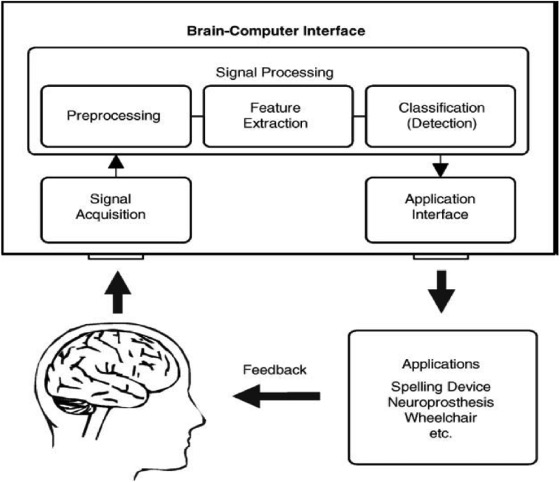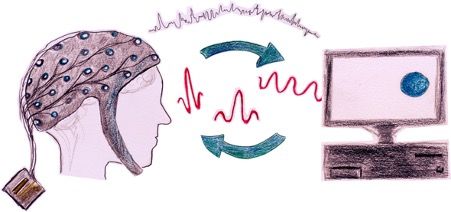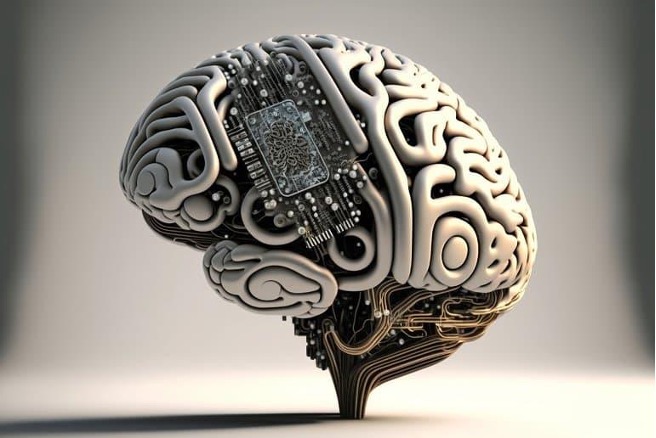Brain-Computer Interface (BCI) is a technology that establishes a direct communication pathway between the brain and an external device, bypassing traditional pathways such as muscles and nerves. It enables the transmission of signals between the brain and a computer or other devices, allowing for the control of external devices or the exchange of information without the need for physical movement or speech.
Brain-Computer Interface (BCI) technology operates by establishing a direct link between the brain and an external device, like a computer or a prosthetic branch. It begins with the accession of neural signals, either through invasive styles involving implanted electrodes or non-invasive ways like EEG. These signals undergo signal processing to enhance their quality and excerpt applicable features, which are also anatomized using pattern recognition algorithms to classify commands or intentions. The decrypted commands are restated into conduct that controls the external device, enabling users to interact with computers, prosthetics, or other interfaces using their studies alone. BCIs frequently incorporate feedback mechanisms to provide users with real- time information about their brain exertion, easing literacy and adaptation over time. Overall, BCIs offer a direct means of communication and control for individualities with severe motor disabilities, with implicit operations in assistive technology, recuperation, and mortal-computer commerce.

The origin of Brain-Computer Interfaces (BCIs) can be traced back to the mid-20th century when researchers began exploring the possibility of directly interfacing the human brain with computers. Here are some key milestones in the development of BCIs:
Early Electrical Stimulation Studies (Late 19th to Early 20th Century):
The groundwork for BCIs was laid with early studies on the electrical activity in the brain. Pioneering work by scientists such as Luigi Galvani and Alessandro Volta in the late 18th century demonstrated the electrical nature of neural signals.
Discovery of Brain Waves (1920s-1930s):
Hans Berger, a German psychiatrist, conducted groundbreaking research in the 1920s that led to the discovery of electroencephalography (EEG). Berger’s work revealed the presence of rhythmic electrical patterns in the human brain, known as brain waves, which laid the foundation for non-invasive BCI technology.
Early EEG-Based BCIs (1960s-1970s):
In the 1960s and 1970s, researchers began experimenting with EEG-based BCIs. Notably, Jose Delgado, a Spanish neuroscientist, conducted pioneering studies on brain stimulation and developed techniques for controlling animal behaviour using implanted electrodes.
Development of Invasive BCIs (1970s-1980s):
In the 1970s and 1980s, researchers like Theodore W. Berger and Eberhard E. Fetz made significant strides in developing invasive BCIs. They demonstrated the feasibility of directly interfacing electrodes with the brain to record neural signals and control external devices in animals.
Emergence of Non-Invasive BCIs (1980s-1990s):
During the 1980s and 1990s, advancements in signal processing and computing technology led to the development of non-invasive BCIs based on EEG and other neuroimaging techniques. Researchers like Niels Birbaumer and Jonathan R. Wolpaw pioneered the use of EEG for communication and control in humans with disabilities.
Modern Era of BCIs (2000s-Present):
The 21st century has witnessed rapid progress in BCI research and development, driven by advances in neuroscience, engineering, and computing. Innovations in electrode technology, signal processing algorithms, and machine learning have led to improved BCI performance and expanded application domains.
Commercial companies and academic institutions are actively working on BCI technologies for applications ranging from assistive devices and healthcare to gaming and neurofeedback.

The development of Brain-Computer Interfaces (BCIs) has seen remarkable progress across multiple disciplines, driven by advancements in technology, neuroscience, and interdisciplinary collaboration.
One of the most significant areas needed for development is falsehood in signal processing and decoding algorithms. These algorithms, frequently using machine literacy and deep literacy ways, have greatly enhanced the capability to prize meaningful information from neural signals recorded by BCIs. This advancement has led to more accurate and dependable BCI systems, enabling precise control of external bias and brisk communication between the brain and computer interfaces.
Another crucial advancement is the miniaturisation of BCI and the emergence of wearable bias. These developments have made BCIs more accessible and user-friendly, allowing for real- time monitoring of brain exertion outside of traditional laboratory settings. Wearable EEG headsets, EMG detectors, and other biosensing biases have opened upnew possibilities for nonstop health monitoring, neurofeedback training, and intuitive control of consumer electronics.
Integration with virtual reality (VR) and augmented reality (AR) technologies represents another significant development in the BCI field. BCI-controlled VR/ AR systems offer immersive gests and natural commerce in digital surroundings. By rephrasing users’ neural signals into real-time commands, these integrated systems give a more intuitive interface, with operations ranging from gaming and training to remedy and simulations.
Advancements in invasive BCI technologies have also made significant strides. High- viscosity electrode arrays and microelectrode technologies enable precise mapping of neural exertion and fine control of prosthetic branches, communication bias, and neural implants. While invasive BCIs pose challenges related to surgical implantation and long- term biocompatibility, ongoing exploration aims to address these issues and unleash their full eventuality for clinical operations.
Non-invasive neuroimaging ways, similar as EEG, fNIRS, and fMRI, continue to evolve, offering precious perceptivity into brain function. Inventions in detector technology, signal processing, and machine literacy have enhanced the spatial and temporal resolution of these ways, enabling more precise mapping of brain exertion patterns. Non-invasive BCIs hold pledge for operations in neurofeedback training, cognitive improvement, internal health monitoring, and assistive technology.

Mongrel and multi-modal BCIs combine different neuroimaging modalities or integrate neural signals with other physiological data sources. These approaches offer new avenues for perfecting signal trustability and enhancing the stoner experience. Multi-modal BCIs, combining brain signals with eye shadowing, stir prisoner, or physiological detectors, enable richer relations and deeper perceptivity into mortal cognition.
Clinical restatement of BCIs is progressing, with operations in neurological recuperation, assistive technology, and healthcare. Clinical trials and real-world deployments of BCI- grounded interventions are underway for stroke recuperation, motor restoration, communication backing, and neuropsychiatric diseases. While challenges remain, including nonsupervisory blessing, clinical confirmation, and ethical considerations, the progress in BCI technology holds pledge for perfecting the quality of life for individuals with disabilities and neurological conditions.
Recently, several companies are actively involved in the research, development, and commercialization of Brain-Computer Interface (BCI) technologies. These companies range from startups to established firms, and they focus on various aspects of BCI, including medical applications, consumer devices, and neurotechnology research. Here are some notable companies in the BCI space:
Neurable: Neurable is a startup that develops non-invasive BCI solutions for various applications, including gaming, healthcare, and virtual reality (VR). Their technology enables users to control digital interfaces using their brain activity, allowing for hands-free interaction in immersive environments.
Kernel: Kernel is a neurotechnology company that aims to develop advanced brain interfaces to understand and treat neurological disorders. Their research focuses on developing implantable devices and neural prosthetics to augment human cognition and restore sensory or motor function.
CTRL-labs (acquired by Meta): CTRL-labs, now part of Meta (formerly Facebook), is known for its innovative electromyography (EMG)-based wristband technology. The wristband detects electrical signals from muscles in the forearm, enabling intuitive control of digital devices and virtual environments through natural hand gestures.
Emotiv: Emotiv is a company that produces EEG-based BCI devices for research, education, and consumer applications. Their products include EEG headsets capable of measuring brain activity and interpreting mental commands for controlling computers, games, and other devices.
OpenBCI: OpenBCI is an open-source hardware and software company that provides accessible BCI tools for researchers, developers, and enthusiasts. They offer modular EEG systems, biosensing devices, and software platforms for prototyping and experimenting with brain-computer interfaces.
BrainGate (by Blackrock Microsystems): BrainGate is a research consortium and clinical trial initiative focused on developing intracortical BCI technology for individuals with severe motor disabilities. The initiative is supported by Blackrock Microsystems, a company specializing in neural interface technology and neural recording systems.
Paradromics: Paradromics is developing high-bandwidth, high-resolution BCI systems for applications in neuroscience research and clinical settings. Their technology aims to enable bidirectional communication between the brain and external devices with unprecedented data throughput and spatial resolution.
As BCIs continue to evolve, ethical, legal, and societal implications are increasingly being addressed to ensure responsible innovation and equitable access to BCI technologies. Ethical frameworks, regulatory guidelines, and stakeholder engagement are essential for fostering trust and promoting positive societal impact. By addressing these considerations, the BCI community can pave the way for the continued advancement and integration of neurotechnology into society.
Written by – Nikita Tiwari
Edited by – Anushka Bhutani
